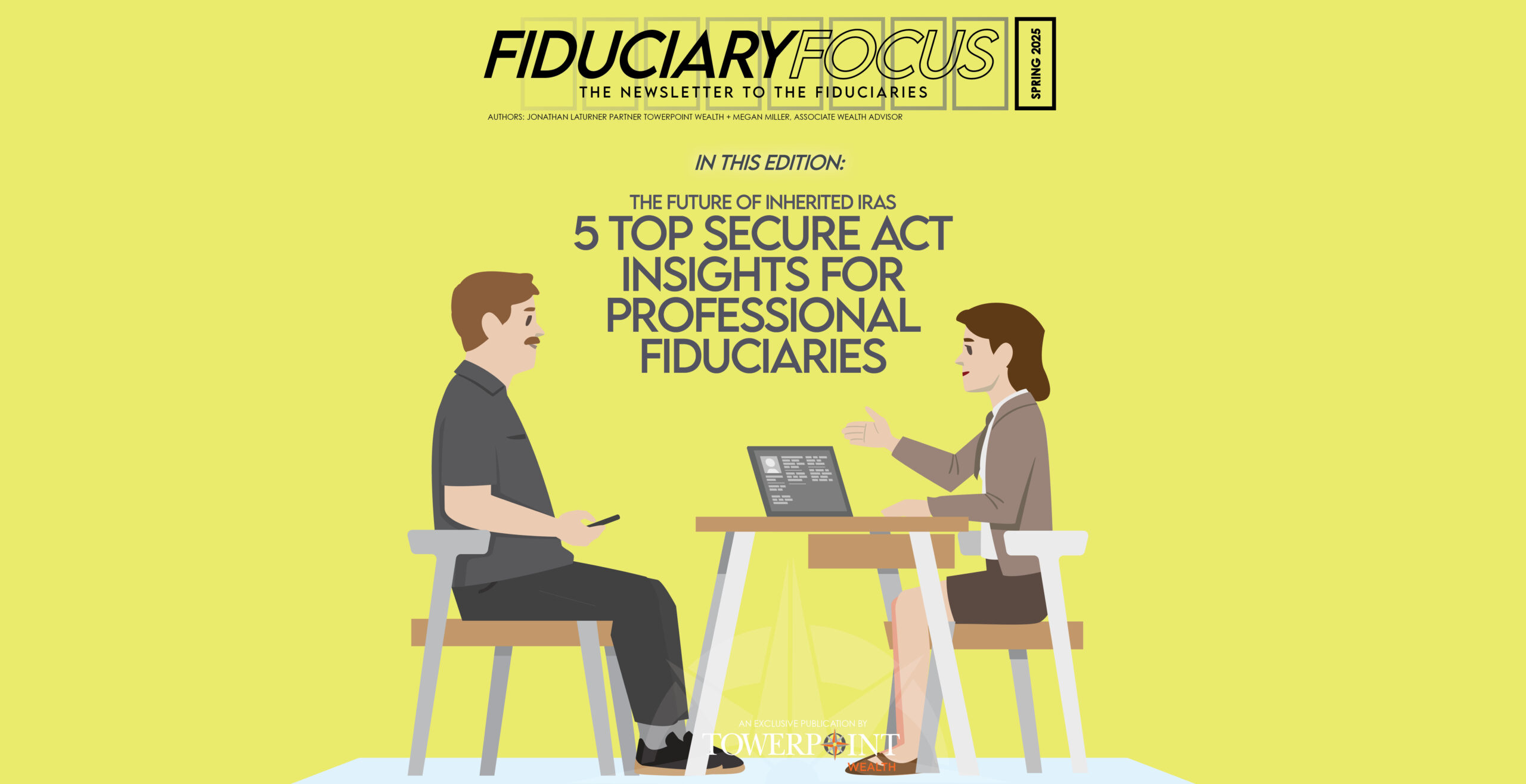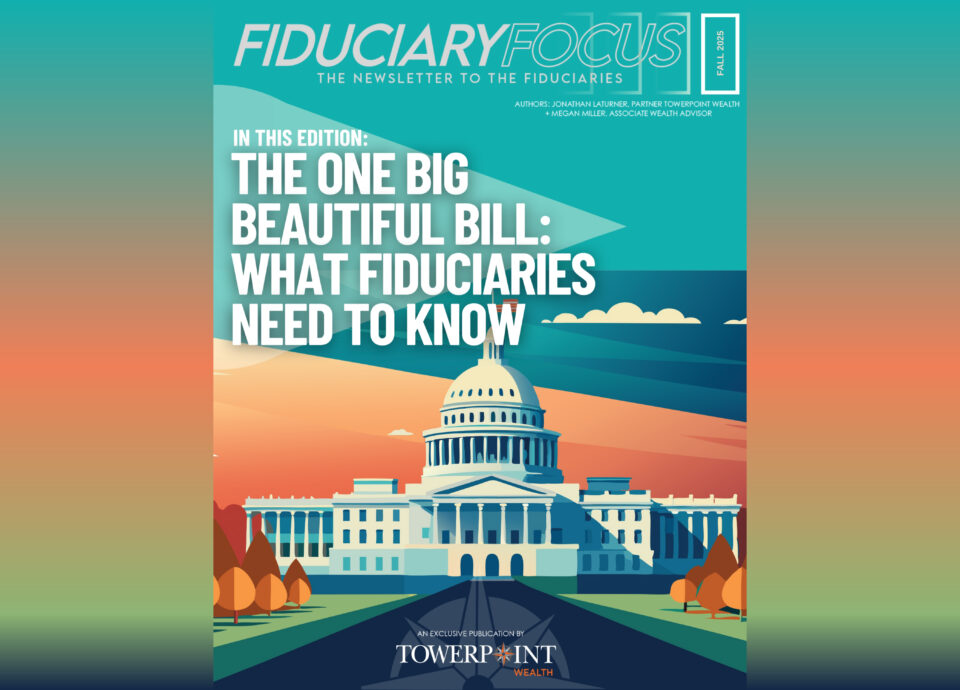Welcome to the February 2025 edition of Towerpoint Wealth’s Fiduciary Group Newsletter, Fiduciary Focus!
As fiduciaries ourselves, we understand the critical responsibility that comes with being entrusted to shield our clients’ assets. We’re here to provide you with fresh insights and practical tools to help you diligently navigate Trust Administration, Special Needs Planning, Conservatorships, and Estate Administration.
Drawing on 27 years of combined experience, our Fiduciary Group at Towerpoint Wealth offers guidance to professional private fiduciaries, third-party trustees, conservators, administrators, and family members. As an independent Registered Investment Advisory firm, we adhere to the same fiduciary standards as the professionals we serve. This dedication ensures that every recommendation aligns with the Uniform Prudent Investor Act and California State Probate Code.
With the new year underway, we remain committed to giving you the support and expertise you need to carry out your fiduciary duties effectively. Whether you’re seeking clarity on complex regulatory matters or looking to provide better service to your clients, our goal is to equip you with the knowledge and resources you need to excel.
We hope you find this newsletter both informative and empowering as you continue to uphold the highest standards of fiduciary care in 2025. We hope you enjoy this edition of Fiduciary Focus!
The 5 Things Professional Fiduciaries Should Know About the New Trust Inherited IRA Regulations
Welcome to our 2025 edition of Fiduciary Focus! In this issue, we’re going to dive into the new Inherited IRA & Required Minimum Distribution (RMD) rules under SECURE Act 2.0 and their implications for fiduciaries managing trusts.
With the shift away from “stretch IRAs” to more restrictive timelines, it’s critical for professional fiduciaries to understand how these regulations affect tax strategies, distribution requirements, and compliance obligations. Let’s discuss how you can navigate these changes to better serve your clients.
What is the SECURE 2.0 Act?
The SECURE Act 2.0 builds on the original SECURE Act’s overhaul of inherited IRA rules, which introduced the 10-year rule for many beneficiaries. This shift effectively eliminated the “stretch IRA” strategy for most non-spouse beneficiaries, accelerating timelines for required withdrawals.
With the latest updates, the IRS has clarified how required minimum distributions (RMDs) work under the new framework, highlighting the importance of staying informed and adjusting trust language to align with these changes.
1. The 10-Year Rule
One of the most significant changes introduced by the SECURE Act is the 10-year distribution requirement for most non-spouse beneficiaries. This rule requires that the inherited IRA funds be fully distributed within a decade of the original owner’s death, effectively limiting the “stretch IRA” strategy many beneficiaries previously enjoyed.
While this change may simplify some aspects of distribution, it can also trigger substantial tax consequences if not managed carefully. For fiduciaries handling trusts, it’s crucial to review the trust’s terms to ensure they don’t inadvertently force premature distributions or create unintended tax burdens. Proper planning here can help you preserve a trust’s overall value.
2. Exceptions to the 10-Year Rule
While the 10-year rule governs most inherited IRAs, certain beneficiaries are exempt from these compressed timelines.
Known as “eligible designated beneficiaries” (EDBs), this group includes surviving spouses, minor children of the decedent (under the age of 21), and individuals who are disabled or chronically ill. EDBs may still have the option to stretch out distributions over their lifetime, helping to minimize the annual tax impact.
For fiduciaries overseeing trusts, identifying whether a beneficiary meets EDB criteria is a crucial responsibility. Using the right trust provisions can preserve a more favorable tax schedule for beneficiaries. This not only aligns with the beneficiary’s best interests, but also ensures greater long-term value of the assets.
3. Required Minimum Distributions (RMDs)
The SECURE Act 2.0 brought additional clarity on how annual RMDs interact with the 10-year rule. In some cases, beneficiaries may need to take yearly withdrawals rather than waiting until the end of the 10-year period to empty the account.
If the original IRA owner was already subject to RMDs, the beneficiary typically must continue taking them. As a fiduciary, it’s essential to confirm whether the trust’s beneficiaries fall under these provisions. Missing an RMD deadline can trigger substantial IRS penalties, so timely guidance can save clients both stress and money.
4. The 5-Year Rule
The 5-Year Rule for Inherited IRAs applies in specific cases when the entire IRA balance must be withdrawn within five years of the original owner’s death. This rule generally applies to non-designated beneficiaries — such as when an IRA has no individual beneficiary, or it is left to an estate, charity, or non-qualifying trust — and when the original owner passed away before reaching their Required Beginning Date (RBD) for taking RMDs (now 72, 73, or 75 depending on their birth year per SECURE 2.0).
If the owner hadn’t yet started RMDs, the 5-Year Rule applies unless the beneficiary qualifies for lifetime distributions. Under this rule, no annual RMDs are required; however, the entire account must be fully distributed by December 31 of the fifth year following the owner’s death.
Conversely, if the original owner had already begun taking RMDs, the 5-Year Rule would not apply, and distributions would instead follow the original schedule or the 10-Year rule.
For example, if an IRA owner dies at age 65, before reaching their RMD age, and names his estate as the beneficiary, the estate must withdraw the full IRA balance by December 31 of the fifth year after his death. This accelerated distribution timeline can lead to a concentrated tax impact, making it crucial for responsible fiduciaries to plan accordingly.
5. Ongoing Regulatory Changes and Compliance
The regulatory landscape surrounding Inherited IRAs continues to evolve, with the IRS regularly issuing new guidance on the practical application of SECURE Act 2.0. Even minor updates can alter timelines, distribution methods, or reporting requirements. As a fiduciary, remaining vigilant is key — subscribing to official IRS updates, attending professional webinars, and consulting with tax and estate planning experts can help you stay ahead of these shifts.
By proactively adjusting trust documents and distribution strategies in response to emerging regulatory changes, you can more effectively serve your clients’ best interests and fulfill your fiduciary duties. Proactive compliance isn’t just about avoiding penalties, but about optimizing the financial outcomes for the clients you serve.
Staying Ahead of the Curve
Navigating the updated Inherited IRA regulations under SECURE Act 2.0 can be complex, but remaining informed and proactive is key to fulfilling your fiduciary responsibilities. By understanding the 10-year rule, potential exceptions, RMD requirements, and the need to revisit trust design, you’ll better serve your clients’ long-term interests.
If you have questions about updating existing trusts, crafting new strategies, or staying on top of regulatory developments, feel free to contact our Fiduciary Group for personalized guidance.
Economic Market Update: Interest Rates and Consumer Impact
The recent Federal Reserve meeting sets a cautious tone for 2025. After implementing 100 basis points in rate cuts late last year, the Fed has now opted for a “wait and see” approach, pausing further rate changes while they closely monitor incoming economic data.
The latest FOMC statement reflects subtle shifts — labor market conditions are now described as stable rather than weakening, and instead of progress toward a 2% inflation target, the language simply states that inflation “remains somewhat elevated.” This change hints at a more “hawkish” outlook, even as the Fed maintains its current policy stance, prepared to adjust if economic data, such as labor trends or M2 growth, indicate the need.
For fiduciaries managing client assets, these developments highlight the importance of staying agile. The potential for higher borrowing costs and shifts in fixed-income yields could impact overall portfolio performance.
Close monitoring of market conditions and timely adjustments in asset allocation strategies will be critical. This proactive approach can help safeguard client investments amid an evolving economic landscape, ensuring that portfolios remain resilient while navigating the uncertainties ahead.
Towerpoint Wealth’s Fiduciary Group Updates
Catch Our Newest Podcast Episode!
Check out our latest episode of "A Wealth of Knowledge", Towerpoint Wealth’s original podcast, where we dive into the intricate world of private professional fiduciaries. In this episode, we dive into the role of a professional fiduciary and how our Fiduciary Group steps in to help fiduciaries navigate this role.
2025 PFAC Conference
We’re thrilled to announce our attendance at the 2025 PFAC (Professional Fiduciaries Association of California) Conference! We look forward to engaging sessions, networking opportunities, and updates on the ever-evolving fiduciary landscape. Mark your calendars for May 7-10, 2025!
Spring Mixer 2025: Mark Your Calendar!
After the success of our previous spring mixers at Revolution Winery + Kitchen in 2023, and The Sutter Club in 2024, we’re thrilled to continue the tradition in 2025! We’ll be announcing this year’s venue in the coming weeks, so stay tuned!
This exclusive, invitation-only event brings together top finance professionals — CPAs, attorneys, fiduciaries, and more — to expand their networks, explore collaborative opportunities, and stay on the cutting edge of industry trends. Keep an eye on your inbox for further details and your official invitation.
We look forward to welcoming you on May 15, 2025!







